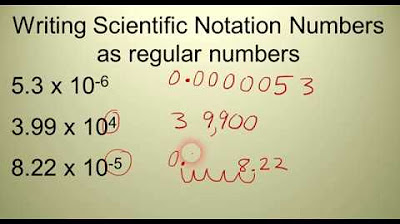BILANGAN BERPANGKAT (EKSPONEN) DAN SIFAT-SIFATNYA | PANGKAT BULAT POSITIF
Summary
TLDRIn this educational video, the presenter explains the concept of exponents, starting with basic definitions and examples, such as simplifying large numbers using exponent notation. The video covers the properties of exponents, including multiplication, division, and the distributive properties. Various examples are provided to demonstrate how to work with exponent expressions. The presenter also addresses more complex topics, such as negative and zero exponents. Throughout, the explanations are clear and illustrated with practical examples, making the topic accessible to viewers looking to deepen their understanding of exponents in mathematics.
Takeaways
- 😀 Exponents simplify the representation of large or small numbers, making it easier to write values like 274 trillion as 2.74 × 10^14.
- 😀 An exponent, such as a^n, represents the repeated multiplication of a by itself n times, where a is the base and n is the exponent.
- 😀 Multiplying numbers with the same base adds the exponents: a^m × a^n = a^(m+n).
- 😀 When dividing numbers with the same base, subtract the exponents: a^m ÷ a^n = a^(m-n).
- 😀 The power of a product rule states that (a × b)^n = a^n × b^n, meaning both factors in parentheses are raised to the power.
- 😀 The power of a quotient rule tells us that (a ÷ b)^n = a^n ÷ b^n, which applies when dividing numbers with exponents.
- 😀 A negative exponent, such as a^-n, is equivalent to 1/a^n.
- 😀 Exponentiation with zero as an exponent (a^0) always equals 1 for any non-zero base a.
- 😀 To multiply exponents with the same base, add the exponents; to divide, subtract them, applying these rules to solve equations more easily.
- 😀 Exponentiation with fractional exponents, like a^(m/n), can be rewritten as the nth root of a raised to the power of m, simplifying complex calculations.
Q & A
What is the main purpose of using exponents?
-Exponents are used to simplify the writing of very large or very small numbers. They help represent numbers in a more manageable form, such as expressing 274 trillion as 2.74 × 10^14.
How do you define an exponent?
-An exponent is defined as repeated multiplication of a number by itself. For example, 'a to the power of n' means multiplying 'a' by itself 'n' times.
What are the components of an exponent expression?
-An exponent expression consists of a base number (a) and an exponent (n). The base is the number being multiplied repeatedly, and the exponent indicates how many times the base is multiplied by itself.
What is an example of exponent notation?
-An example is 2^3, which means 2 multiplied by itself three times (2 × 2 × 2).
How do you convert a multiplication expression like 'a × a × a × a' into exponent notation?
-In exponent notation, 'a × a × a × a' would be written as a^4, indicating that the base 'a' is multiplied by itself four times.
What does the property 'a^m × a^n = a^(m+n)' represent?
-This property states that when you multiply two numbers with the same base, you add their exponents. For example, a^5 × a^3 = a^(5+3) = a^8.
What is the significance of a negative exponent?
-A negative exponent means that the base is moved to the denominator of a fraction. For example, a^(-n) is equal to 1/a^n.
How do you handle division of exponents with the same base?
-When dividing exponents with the same base, subtract the exponent in the denominator from the exponent in the numerator. For example, a^7 / a^3 = a^(7-3) = a^4.
What is the result of raising a product, such as 'a × b', to an exponent?
-When you raise a product to an exponent, you raise each factor separately. For example, (a × b)^n = a^n × b^n.
What happens when you raise a base to a power and then raise that result to another power?
-When raising a power to another power, you multiply the exponents. For example, (a^m)^n = a^(m × n).
Outlines

This section is available to paid users only. Please upgrade to access this part.
Upgrade NowMindmap

This section is available to paid users only. Please upgrade to access this part.
Upgrade NowKeywords

This section is available to paid users only. Please upgrade to access this part.
Upgrade NowHighlights

This section is available to paid users only. Please upgrade to access this part.
Upgrade NowTranscripts

This section is available to paid users only. Please upgrade to access this part.
Upgrade NowBrowse More Related Video
5.0 / 5 (0 votes)





